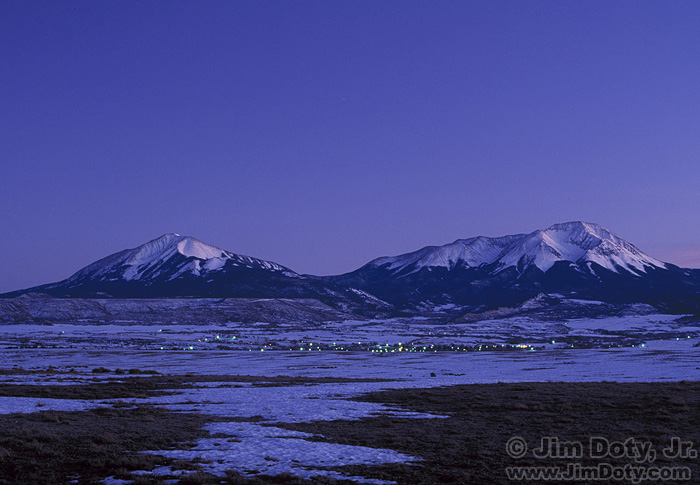
The Spanish Peaks in Colorado are special to me. As a small boy growing up in southern Colorado I could look out our living room window every day and see the Spanish Peaks.
The Story
“We were on our way home to Oklahoma. As we left Denver we decided to take the scenic route. We went south on U.S. 285 and CO 17 toward Alamosa which is one of my favorite scenic drives with beautiful mountains, several mountain ranges, and several mountain passes.
At Alamosa we took U.S. 160 to head east towards I-25. The sun set and it was getting darker as we crossed LaVeta Pass. It was a beautiful evening and toasty warm inside the car. I came over a hill and saw this scene. The lights were coming on in the little town of LaVeta. The Spanish Peaks were catching the last bit of sky glow before dark. I jumped out of the car and used two camera bodies with two different kinds of slide film, alternating back and forth between the two cameras. I didn’t take time to put on gloves because the light was fading fast.
It was a bitter cold, windy evening in early March and my fingers were getting numb. I used my body to block the wind from the tripod as best I could. I didn’t want the wind to jiggle the tripod and blur the increasingly longer exposures.
I used Fujichrome Velvia 50 slide film in one of the Canon F-1 cameras and Kodak slide film in the other. I would guess the aperture was around f/8 or f/11 and the lens was probably a Canon FD 80-200mm f4L zoom lens.
Substitute Metering with Equivalent Exposures
All my meter readings were based on the sky. The foreground and mountains had too many dark and light areas mixed together to make metering reliable.
The maximum shutter speed for the F-1 is 8 seconds so I ran out of shutter speeds as it got darker. So I did substitute metering by substituting an equivalent exposure. For example, I would meter the sky at f/4 (the largest aperture on the lens) and check the recommended shutter speed, then switch to f/8 and add two stops to the shutter speed the meter recommended at f/4. If the meter said f/4 and 4 seconds, I would shoot at the equivalent exposure of f/8 and 15 seconds. Thanks to reciprocity failure, Velvia slows down at shutter speeds this long so I would also lengthen the shutter speed by another stop, making the shutter speed 30 seconds in addition to 15 seconds. In a situation like this it helps to bracket shutter speeds. A cable release with the camera set to B (bulb) made the long shutter speeds possible.
I still use substitute metering when it gets too dark for my digital cameras to meter at apertures like f/8 and f/11. I meter at f/4 (or whatever is the maximum aperture on the lens), take note of the recommended shutter speed, then stop down to my preferred aperture and add the appropriate numbers of stops to the shutter speed. If the camera meter says f/4 at 8 seconds, and I stop down to f/11 (which is 3 stops less light than f/4), I add three stops to the shutter speed and shoot at 1 minute. f/4 at 8 seconds and f/11 at 1 minute are equivalent exposures.
When I got back my processed film I liked the Fuji color rendition better than the Kodak, so I used the Fuji slide version for the photo above.
Photo Locations
There are great photo locations all the way down U.S. 285 and CO 17 from Denver to Alamosa , and if you have time for a side trip, stop at the Great Sand Dunes.
The view of the Spanish Peaks from U.S. 160 is my favorite along that stretch of highway between Alamosa and Colorado.
Link
To learn more about metering, go here.
